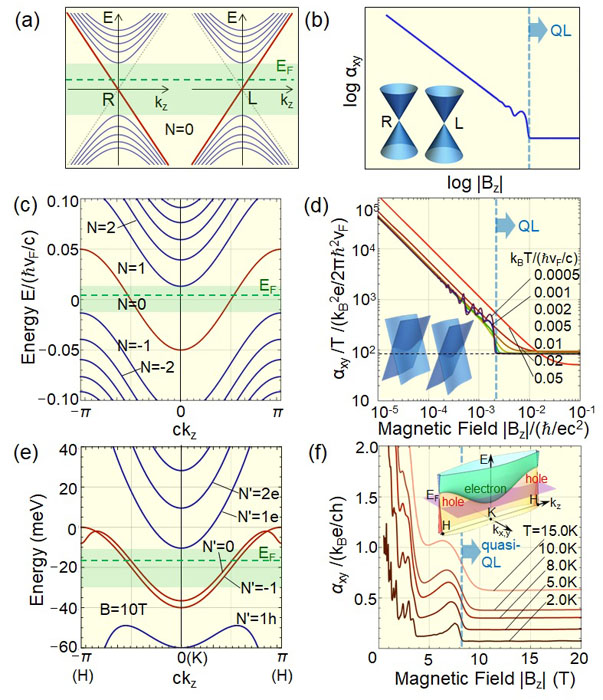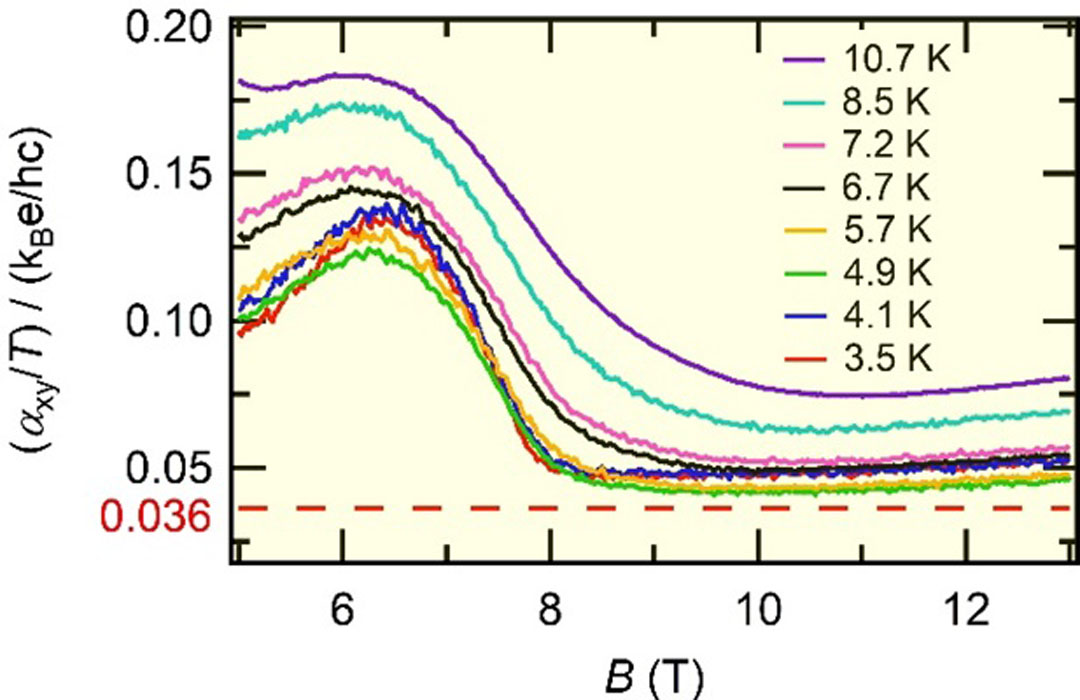Quantized Thermoelectric Hall Effects in Nodal-Line Semimetals at the High-Magnetic-Field Quantum Limit
Osada Group
The “quantized thermoelectric Hall effect (QTHE)” has been established theoretically and experimentally in 3D Dirac/Weyl semimetals with nodal points, at the high-magnetic-field quantum limit (QL). Reflecting their characteristic N = 0 chiral Landau subband (Fig. 1(a)), their thermoelectric Hall conductivity αxy takes a constant value (Fig. 1(b)), which is independent of magnetic field and carrier number, resulting in the boundless linear increase of the Seebeck coefficient Sxx ~ αxy / σxy. This feature brings about high-performance thermoelectricity. The more remarkable QTHE was proposed in the 2D massless Dirac fermion system with nodal points at the QL. In this case, αxy takes a quantized constant value of (4 log2) kB e / h, which is independent of temperature, magnetic field, and carrier density, so that the boundless increase of Sxx can be expected even at low temperatures. Here, we have theoretically and experimentally investigated the possible QTHE in the 3D topological semimetals with straight nodal lines at the QL.
First, we exhibited that the QTHE can more generally appear even in a part of the 3D nodal-line semimetals in addition to the nodal-point semimetals [1]. We considered the 3D semimetals with straight parallel nodal lines. For example, they can be realized as multilayer systems where 2D massless Dirac fermion layers stack with weak interlayer coupling. When the magnetic field is applied parallel to the straight nodal lines, the N = 0 ground Landau subband (Fig. 1(c)), which consists of the N = 0 Landau level of each 2D layer, plays the similar role as the pair of the N = 0 chiral Landau subbands in Dirac/Weyl semimetals, and also causes the similar QTHE (Fig. 1(d)). The constant value of αxycontains the dispersion parameter, and it is proportional to temperature but independent of carrier density.
We quantitatively discussed the possible QTHE in graphite as an example of the nodal-line semimetal [1]. In 3D graphite, the conduction and valence bands quadratically touch along the H-K-H edge of the Brillouin zone, forming nodal lines. Based on the Landau subband configuration obtained from the Slonczewski-Weiss-McClure model (Fig. 1(e)), we calculated αxy as a function of magnetic field and confirmed the QTHE plateau formation with the value αxy(sheet) ~ 0.036 [K-1] T (kB e / h) per bilayer at the quasi-QL |Bz| > 8 T, where only two ground subbands (N’ = -1, 0) locate at the Fermi level (Fig. 1(f)).
Next, we performed the thermoelectric measurement on graphite to confirm the QTHE [2]. The resistivity (ρxx, ρxy) and thermopower (Sxx, Sxy) were measured simultaneously to compute αxy. We could successfully obtain the plateau of αxy at the quasi-QL (Fig. 2), which quantitatively agrees with our calculation. In graphite, the Hall conductivity σxyis not simply proportional to 1/B but shows complicated B-dependence, so that the boundless increase of Sxx cannot be observed.
In addition, we theoretically investigated the quantum size effect on the QTHE in thin-film graphite [1]. When the thickness of graphite is decreased, the Landau subbands is discretized into many levels by the quantization of the interlayer wave number. This causes the dimensional crossover of the QTHE from 3D to 2D.
References
- [1] T. Osada, T. Ochi, and T. Taen, J. Phys. Soc. Jpn. 91, 063701 (2022).
- [2] A. Kiswandhi, T. Ochi, T. Taen, M. Sato, K. Uchida, and T. Osada, Phys. Rev. B 107, 195106 (2023).


